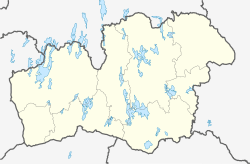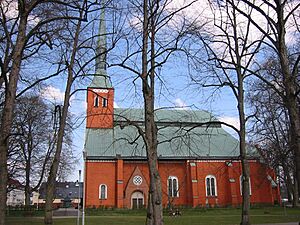Växjö facts for kids
Quick facts for kids
Växjö
|
||
|---|---|---|
|
City
|
||
 |
||
|
||
| Motto(s):
Europe's Greenest City
|
||
| Country | ||
| Province | ||
| County | Kronoberg County | |
| Municipality | Växjö Municipality | |
| Area | ||
| • City | 30.28 km2 (11.69 sq mi) | |
| Elevation | 167 m (548 ft) | |
| Population
(5 September 2017)
|
||
| • City | 66,275 | |
| • Density | 2,011/km2 (5,210/sq mi) | |
| • Metro | 90,721 | |
| Time zone | UTC+1 (CET) | |
| • Summer (DST) | UTC+2 (CEST) | |
| Postal code |
35x xx
|
|
| Area code(s) | (+46) 470 | |
Växjö (Swedish pronunciation: [ˈvɛ̂kːɧøː]) is a city and the seat of Växjö Municipality, Kronoberg County, Sweden. It had 70,489 inhabitants (2019) out of a municipal population of 95,995 (2021). It is the administrative, cultural, and industrial centre of Kronoberg County and the episcopal see of the Diocese of Växjö and the location of Växjö Cathedral. The town is home to Linnaeus University.
Contents
Etymology
The city's name is believed to be constructed from the words väg ("road") and sjö ("lake"), meaning the road over the frozen Växjö Lake that farmers used in the winter to get to the marketplace which later became the city.
History
In contrast to what was believed a century ago, there is no evidence of a special pre-Christian significance of the site. The pagan cultic center of Värend may have been located at Hov, a nearby village.
An episcopal see since the 11th century, the city did not get its city charter until 1342, when it was issued by Magnus Eriksson. The cathedral of St Sigfrid dates from about 1300, and has been subsequently restored. Otherwise, during the Middle Ages, Växjö did not have many pious institutions. A Franciscan monastery was established in 1485. A hospital of the Holy Ghost was first mentioned in 1318. In the 14th century Växjö got its first school, Växjö katedralskola. In 1643 it received gymnasium status.
At the beginning of Gustav Eriksson's war of liberation, the peasantry joined forces, under the guidance of the union-hostile bishop Ingemar Pedersson, with the mountain men and peasantry of Dalarna, Hälsingland, and Gästrikland, who urged fidelity to their leader Gustav Eriksson. During the Dacke War, a peasant uprising, the city was under the authority of Nils Dacke and his supporters from the summer of 1542 until after New Year 1543.

Several times during the Northern Wars and the Scanian Wars, and thereafter, the city was affected by fire (in 1277, 1516, 1570, 1612, 1658, 1690, 1749, 1753, 1799, 1838 and 1843). After the last fire in 1843, when 1,140 citizens were rendered homeless, Växjö received its current street plan.
Modern times
Växjö is the city in which the photograph "A Woman Hitting a Neo-Nazi With Her Handbag" was taken in 1985 by Hans Runesson.
In its December 2015 report, Police in Sweden placed the Växjö district Araby in the most severe category of urban areas with high crime rates.
Historic buildings
Växjö Cathedral is located near the centre of the city.
Immediately north of Växjö is Kronoberg Castle, a ruined fortress constructed in the 15th century. This castle was used as a base by the rebel, Nils Dacke, during the Dacke War. The fortress has thick walls and artillery portals that face north towards lake Helgasjön.
Teleborg Castle is also located near the city. It was built near the Linnaeus University in 1900, it now functions as a hotel and conference facility.
Amenities
The Swedish Emigrant Institute was established in 1965 and is housed in the House of Emigrants near Växjö Lake in the heart of the city. It contains archives, a library, a museum, and a research center relating to the emigration period between 1846 and 1930, when 1.3 million (or 20%) of the Swedish population emigrated, mainly to the United States. Archives dating to the 17th century contain birth and death records, as well as household records, that are available on microfiche.
Industry
Industries include GE Power and Aerotech Telub, as well as Volvo Articulated Haulers which is located in Braås 29 kilometres (18 miles), north of Växjö. One of the best-known service providers is Fortnox and Visma.
Växjö houses Sweden's National Glass Museum and claims to be the capital of the "Kingdom of Crystal" as well as of the "Kingdom of Furniture". Växjö Linnaeus Science Park focuses on supporting entrepreneurs focusing on circular economy, smart city, forestry and digitalization.
Education
The city has three municipality-run secondary schools ("gymnasiums"): Teknikum, Katedralskolan, and Kungsmadskolan. Linnaeus University had a student body of 42,000 students as of 2012[update] (including its Kalmar campus) or 15,000 students (full-time equivalents) as of 2010[update].
Demography
| Historical population | |||||||||||||||||||||||||||||||||||||||||||||||||
|---|---|---|---|---|---|---|---|---|---|---|---|---|---|---|---|---|---|---|---|---|---|---|---|---|---|---|---|---|---|---|---|---|---|---|---|---|---|---|---|---|---|---|---|---|---|---|---|---|---|
|
|
||||||||||||||||||||||||||||||||||||||||||||||||
Population numbers by city districts
- Teleborg: 12,834
- Hovshaga: 9,541
- Hov: 8,020
- Araby: 6,520
- Norr: 4,518
- Väster: 4,829
- Öster: 4,489
- Söder: 3,694
- Sandsbro: 3,090
- Högstorp: 2,710
- Öjaby: 2,213
- Centrum: 2,086
- Räppe: 1,260
- Kronoberg/Evedal: 279
- Regementstaden: 88
- Västra mark: 69
- Norremark: 29
Transport
The Coast to Coast track cuts through the municipality from north-west to south-east. SJ's long-distance trains travel between Gothenburg, Alvesta (with connections to the southern trunk line) and Kalmar, with stop in Växjö. Öresundståg's long-distance trains travel the Kalmar – Alvesta – Malmö - Copenhagen route. Regional trains Krösatågen travel the Växjö – Jönköping route. Trunk roads 23, 25, 27, 29, 30 and 37 meet in the municipality.
A new city hall and railway station building was completed in 2021.
In air transport, the city is served by the nearby Växjö/Kronoberg Airport.
Environmental policy
In 1996 the city adopted a policy for the elimination of the use of fossil fuels by 2030. This decision was taken in reaction to pollution and eutrophication in the lakes that surround the town. Greenhouse gas emissions were cut by 41% from 1993 to 2011, and were reduced by 55% by 2015. The city's economy has grown during this time.
Växjö uses a variety of strategies to make progress towards being fossil fuel-free. Waste from the local forest industry is burned to generate power. Half of Växjö's electricity and over 90% of the energy used for heating comes from trees. Biogas and renewable energy fuel the city's public transportation, and cycling is promoted as an alternative mode of transport. New buildings are constructed using wood and are designed to be energy efficient.
By 2014, Växjö's CO2 emissions had dropped to 2.4 tonnes per capita, well below the EU average of 7.3 tonnes.
The Greenest City in Europe
Växjö has called itself "The Greenest City in Europe" since 2007. It has its foundation in a long history of commitment to environmental issues, and ambitious goals for a green future. It is a vision shared with the citizens and the local companies.
In 2017 Växjö was awarded the European Green Leaf Award 2018 by the European Commission. The prize is awarded to cities with less than 100 000 inhabitants that show good results and ambitions in terms of environment and are committed to generate green growth.
Notable people
- Joachim Björklund, footballer
- Jonas Björkman, tennis player with 50 doubles titles including Grand Slams
- Karl-Birger Blomdahl, 20th century music composer
- Maria Cederschiöld (deaconess)
- Bjorn Englen, bass player of Yngwie Malmsteen's Rising Force
- Knute Heldner, 20th-century Swedish American artist
- Emil Johansson (ice hockey), Ice Hockey player for the Providence Bruins of the AHL
- Stefan Johansson, Formula 1 racing driver
- Jonas Jonasson, writer
- Owe Jonsson, track and field athlete and European champion
- Martin Kellerman, comic strip creator
- Carolina Klüft, track and field athlete and Olympic gold medalist at Athens 2004
- Pär Lagerkvist, author and winner of the Nobel Prize in Literature, 1951
- Otto Lindblad, 19th century music composer
- Carl Linnaeus, botanist, physician and zoologist
- Melody Club, rock band
- Christina Nilsson, 19th century soprano celebrity
- Andreas Ravelli, footballer
- Thomas Ravelli, football goalkeeper
- Sophie Sager, 19th century writer and feminist
- Peder Sjögren, 20th century author and playwright
- Jonas Swensson, President of the Augustana Evangelical Lutheran Church
- Håkan Syrén, a military General and Supreme Commander of the Swedish Armed Forces
- Esaias Tegnér, poet and bishop of Växjö
- Per Tengstrand, pianist
- Mats Wilander, tennis player with seven Grand Slam victories 1982–1988
- Björn Wirdheim, racing driver
- The Ark, rock band
Sport and leisure
The following sports clubs are located in Växjö:
- Östers IF – football
- Hovshaga AIF – football, floorball, and tennis
- Växjö BK – football
- Växjö Lakers – ice hockey
- Växjö Vipers – floorball
- Wexjö RK – rugby
- Växjö Ravens BBK - basketball
- Växjö OK – orienteering
- Växjö DFF – football
- Växjö United FC – football
- Växjö VK – Volleyball
Speedway
- A speedway team rode at the Växjö Motorstadion, inaugurated on 5 June 1949 (the site of the current Räppe football pitch on Solängsvägen). They team competed in the 1950 Swedish speedway season before being the home for Dackarna in 1956. The venue held rounds of the Individual Speedway World Championship in 1952, 1957 and 1958.
Climate
Växjö has a humid continental climate (Dfb), using temperature data from 1961 to 1990. Temperatures have risen in recent years, and using the -3 Celsius isotherm, it can also be classified as an oceanic climate (Cfb) with 2002-2015 temperature data. It is milder, wetter, and cloudier than the rest of the country, with the number of hours of sunshine being associated more with the British Isles than with areas further north in Sweden. Considering its relative distance to all three coasts surrounding South Sweden, the climate is markedly maritime, with winter temperatures being relatively mild for an inland location. When compared with sunnier inland areas further north, Växjö has relatively cool summers.
| Climate data for Växjö (2002–2018 averages, extremes since 1901) | |||||||||||||
|---|---|---|---|---|---|---|---|---|---|---|---|---|---|
| Month | Jan | Feb | Mar | Apr | May | Jun | Jul | Aug | Sep | Oct | Nov | Dec | Year |
| Record high °C (°F) | 9.6 (49.3) |
13.8 (56.8) |
20.0 (68.0) |
27.9 (82.2) |
29.0 (84.2) |
32.5 (90.5) |
33.5 (92.3) |
34.4 (93.9) |
27.6 (81.7) |
21.9 (71.4) |
14.0 (57.2) |
11.3 (52.3) |
34.4 (93.9) |
| Mean maximum °C (°F) | 6.4 (43.5) |
6.9 (44.4) |
13.4 (56.1) |
19.3 (66.7) |
24.6 (76.3) |
26.9 (80.4) |
28.6 (83.5) |
27.4 (81.3) |
22.7 (72.9) |
16.4 (61.5) |
10.8 (51.4) |
7.5 (45.5) |
29.5 (85.1) |
| Mean daily maximum °C (°F) | 0.5 (32.9) |
1.1 (34.0) |
5.4 (41.7) |
11.9 (53.4) |
17.0 (62.6) |
20.0 (68.0) |
22.5 (72.5) |
21.0 (69.8) |
17.0 (62.6) |
10.4 (50.7) |
5.5 (41.9) |
2.3 (36.1) |
11.2 (52.2) |
| Daily mean °C (°F) | −1.7 (28.9) |
−1.4 (29.5) |
1.6 (34.9) |
6.8 (44.2) |
11.6 (52.9) |
14.7 (58.5) |
17.5 (63.5) |
16.4 (61.5) |
12.8 (55.0) |
7.2 (45.0) |
3.4 (38.1) |
0.3 (32.5) |
7.4 (45.4) |
| Mean daily minimum °C (°F) | −3.8 (25.2) |
−3.8 (25.2) |
−2.3 (27.9) |
1.6 (34.9) |
6.2 (43.2) |
9.4 (48.9) |
12.4 (54.3) |
11.8 (53.2) |
8.6 (47.5) |
4.2 (39.6) |
1.3 (34.3) |
−1.8 (28.8) |
3.7 (38.6) |
| Mean minimum °C (°F) | −13.8 (7.2) |
−12.1 (10.2) |
−10.0 (14.0) |
−3.6 (25.5) |
0.2 (32.4) |
4.2 (39.6) |
7.7 (45.9) |
6.7 (44.1) |
2.2 (36.0) |
−3.5 (25.7) |
−6.4 (20.5) |
−10.6 (12.9) |
−16.2 (2.8) |
| Record low °C (°F) | −34.0 (−29.2) |
−28.8 (−19.8) |
−29.8 (−21.6) |
−19.0 (−2.2) |
−6.0 (21.2) |
−0.8 (30.6) |
3.5 (38.3) |
0.0 (32.0) |
−4.8 (23.4) |
−10.3 (13.5) |
−17.8 (0.0) |
−24.5 (−12.1) |
−34.0 (−29.2) |
| Average precipitation mm (inches) | 50.5 (1.99) |
36.0 (1.42) |
31.7 (1.25) |
28.8 (1.13) |
51.6 (2.03) |
67.3 (2.65) |
89.6 (3.53) |
77.9 (3.07) |
49.4 (1.94) |
64.6 (2.54) |
57.0 (2.24) |
54.6 (2.15) |
659 (25.94) |
| Mean monthly sunshine hours | 32 | 57 | 143 | 203 | 236 | 238 | 234 | 191 | 153 | 88 | 37 | 24 | 1,636 |
| Source 1: SMHI | |||||||||||||
| Source 2: SMHI Monthly Data | |||||||||||||
See also
 In Spanish: Växjö para niños
In Spanish: Växjö para niños






